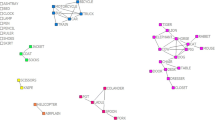Abstract
The paper introduces definitions of exclusion relations in spaces of features and concepts. Concepts correspond to phenomena and they are described with their features. The objective of our research is to investigate and describe possible structuring and relations in the feature and concept spaces. In this article, three types of exclusions: weak, strict, and multiple qualitative are defined and discussed. The focus is on similarity of excluding structures. Two distinct methodologies are introduced. First approach relies on direct features comparison. Second methodology uses dedicated similarity relation rooted in the underlying concept space.
Access this chapter
Tax calculation will be finalised at checkout
Purchases are for personal use only
Similar content being viewed by others
References
Atanassov, K.T.: Intuitionistic fuzzy sets. Fuzzy Sets Syst. 20, 87–96 (1986)
Homenda, W.: Balanced fuzzy sets. Inf. Sci. 176(17), 2467–2506 (2006)
Homenda, W., Pedrycz, W.: Balanced fuzzy computing unit. Int. J. Uncertain. Fuzziness Knowl. Based Syst. 13(2), 117–138 (2005)
Homenda, W., Pedrycz, W.: Balanced fuzzy gates. In: Greco, S., Hata, Y., Hirano, S., Inuiguchi, M., Miyamoto, S., Nguyen, H.S., Słowiński, R. (eds.) RSCTC 2006. LNCS (LNAI), vol. 4259, pp. 107–116. Springer, Berlin (2006)
Homenda, W., Pedrycz, W.: Symmetrization of fuzzy operators: notes on data aggregation. In: Halgamuge, S.K., Wang, L. (eds.) Computational Intelligence for Modelling and Prediction. Studies in Computational Intelligence, vol. 2, pp. 1–17. Springer, Berlin (2005)
Jastrzebska, A.: Similarity of exclusions in the concept space. In: Skulimowski, A.M.J. (ed.) 8th International Conference on Knowledge, Information and Creativity Support Systems, pp. 245–256. Progress & Business Publishers (2013)
Julian-Iranzo, P.: A procedure for the construction of a similarity relation. In: Magdalena, L., Ojeda-Aciego, M., Verdegay, J.L. (eds.) 12th International Conference on Information Processing and Management of Uncertainty in Knowledge-Based Systems, pp. 489–496 (2008)
Klawonn, F., Kruse, R.: Similarity relations and independence concepts. In: Della Riccia, G., Dubois, D., Kruse, R., Lenz, H.J. (eds.) Preferences and Similarities, pp. 179–196. Springer, Wien (2008)
Lin, D.: An Information-theoretic definition of similarity. In: Shavlik, J.V. (ed.) 15th International Conference on Machine Learning, pp. 296–304. Morgan Kaufmann (1998)
Orozco, J., Belanche, L.: On aggregation operators of transitive similarity and dissimilarity relations. In: 13th IEEE International Conference on Fuzzy Systems, pp. 1373–1377. IEEE Press (2004)
Tversky, A.: Features of similarity. Psychol. Rev. 84(4), 327–352 (1977)
Acknowledgments
A. Jastrzebska contribution is supported by the Foundation for Polish Science under International PhD Projects in Intelligent Computing. Project financed from The European Union within the Innovative Economy Operational Programme (2007–2013) and European Regional Development Fund. W. Lesinski’s research is supported by the National Science Center, grant No 2011/01/B/ST6/06478, decision no DEC-2011/01/B/ST6/06478.
Author information
Authors and Affiliations
Corresponding author
Editor information
Editors and Affiliations
Rights and permissions
Copyright information
© 2016 Springer International Publishing Switzerland
About this paper
Cite this paper
Jastrzebska, A., Lesinski, W. (2016). Modeling in Feature and Concept Spaces: Exclusion Relations and Similarities of Features Related with Exclusions. In: Skulimowski, A., Kacprzyk, J. (eds) Knowledge, Information and Creativity Support Systems: Recent Trends, Advances and Solutions. Advances in Intelligent Systems and Computing, vol 364. Springer, Cham. https://doi.org/10.1007/978-3-319-19090-7_33
Download citation
DOI: https://doi.org/10.1007/978-3-319-19090-7_33
Published:
Publisher Name: Springer, Cham
Print ISBN: 978-3-319-19089-1
Online ISBN: 978-3-319-19090-7
eBook Packages: Computer ScienceComputer Science (R0)




